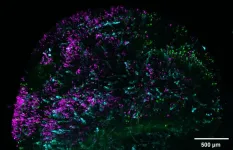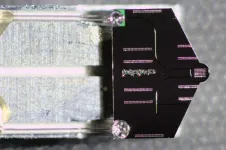(Press-News.org) With human retinas grown in a petri dish, researchers discovered how an offshoot of vitamin A generates the specialized cells that enable people to see millions of colors, an ability that dogs, cats, and other mammals do not possess.
“These retinal organoids allowed us for the first time to study this very human-specific trait,” said author Robert Johnston, an associate professor of biology. “It’s a huge question about what makes us human, what makes us different.”
The findings, published in PLOS Biology, increase understanding of color blindness, age-related vision loss, and other diseases linked to photoreceptor cells. They also demonstrate how genes instruct the human retina to make specific color-sensing cells, a process scientists thought was controlled by thyroid hormones.
By tweaking the cellular properties of the organoids, the research team found that a molecule called retinoic acid determines whether a cone will specialize in sensing red or green light. Only humans with normal vision and closely related primates develop the red sensor.
Scientists for decades thought red cones formed through a coin toss mechanism where the cells haphazardly commit to sensing green or red wavelengths—and research from Johnston’s team recently hinted that the process could be controlled by thyroid hormone levels. Instead, the new research suggests red cones materialize through a specific sequence of events orchestrated by retinoic acid within the eye.
The team found that high levels of retinoic acid in early development of the organoids correlated with higher ratios of green cones. Similarly, low levels of the acid changed the retina’s genetic instructions and generated red cones later in development.
“There still might be some randomness to it, but our big finding is that you make retinoic acid early in development,” Johnston said. “This timing really matters for learning and understanding how these cone cells are made.”
Green and red cone cells are remarkably similar except for a protein called opsin, which detects light and tells the brain what colors people see. Different opsins determine whether a cone will become a green or a red sensor, though the genes of each sensor remain 96% identical. With a breakthrough technique that spotted those subtle genetic differences in the organoids, the team tracked cone ratio changes over 200 days.
“Because we can control in organoids the population of green and red cells, we can kind of push the pool to be more green or more red,” said author Sarah Hadyniak, who conducted the research as a doctoral student in Johnston’s lab and is now at Duke University. “That has implications for figuring out exactly how retinoic acid is acting on genes.”
The researchers also mapped the widely varying ratios of these cells in the retinas of 700 adults. Seeing how the green and red cone proportions changed in humans was one of the most surprising findings of the new research, Hadyniak said.
Scientists still don’t fully understand how the ratio of green and red cones can vary so greatly without affecting someone’s vision. If these types of cells determined the length of a human arm, the different ratios would produce “amazingly different” arm lengths, Johnston said.
To build understanding of diseases like macular degeneration, which causes loss of light-sensing cells near the center of the retina, the researchers are working with other Johns Hopkins labs. The goal is to deepen their understanding of how cones and other cells link to the nervous system.
“The future hope is to help people with these vision problems,” Johnston said. “It's going to be a little while before that happens, but just knowing that we can make these different cell types is very, very promising.”
Other Johns Hopkins authors include: Kiara C. Eldred, Boris Brenerman, Katarzyna A. Hussey, Joanna F. D. Hagen, Rajiv C. McCoy, Michael E. G. Sauria, and James Taylor; as well as James A. Kuchenbecker, Thomas Reh, Ian Glass, Maureen Neitz, Jay Neitz of the University of Washington.
END
Lab-grown retinas explain why people see colors dogs can’t
2024-01-11
ELSE PRESS RELEASES FROM THIS DATE:
KAUST scientists unveil blueprint for affordable solar cells to power Saudi Arabia and beyond
2024-01-11
Thuwal, Saudi Arabia, Month Day, Year – Scientists at King Abdullah University of Science and Technology (KAUST) have unveiled a roadmap for bringing perovskite/silicon tandem solar cells to market, paving the way for a future powered by abundant, inexpensive clean energy in Saudi Arabia and the world.
The authors of the article, published in esteemed journal Science, include Prof. Stefaan De Wolf and his research team at the KAUST Solar Center.
The team is working on improving solar efficiency to meet Saudi Arabia’ solar targets.
Perovskite/silicon tandem technology combines the strengths of two materials – perovskite's efficient ...
Quest for personalized medicine hits a snag
2024-01-11
New Haven, Conn. — The quest for personalized medicine, a medical approach in which practitioners use a patient’s unique genetic profile to tailor individual treatment, has emerged as a critical goal in the health care sector. But a new Yale-led study shows that the mathematical models currently available to predict treatments have limited effectiveness.
In an analysis of clinical trials for multiple schizophrenia treatments, the researchers found that the mathematical algorithms were able to predict patient outcomes within the specific ...
Bridging light and electrons
2024-01-11
When light goes through a material, it often behaves in unpredictable ways. This phenomenon is the subject of an entire field of study called “nonlinear optics”, which is now integral to technological and scientific advances from laser development and optical frequency metrology, to gravitational wave astronomy and quantum information science.
In addition, recent years have seen nonlinear optics applied in optical signal processing, telecommunications, sensing, spectroscopy, light detection and ranging. All these applications involve the miniaturization of devices ...
Climate change spells disaster for termite-loving numbats
2024-01-11
Australia is known for its wonderous and unique wildlife. But, just like the rest of the world, Australia is expected to get even hotter because of climate change. This could spell disaster for many of the marsupials that call the drier regions of the country home as it may get too hot for them to handle. To make things even more difficult, many of these marsupials are endangered thanks to habitat loss and introduced species such as domestic cats and red foxes. Therefore, finding a way to study these animals without disturbing them is critical to ensure their survival. This realisation led Christine Cooper (Curtin University, ...
ACIP releases 2024 Adult Immunization Schedule featuring four new vaccines
2024-01-11
Embargoed for release until 1:00 p.m. ET on Thursday 11 January 2024
Annals of Internal Medicine Tip Sheet
@Annalsofim
Below please find a summary for new article that will be published in of Annals of Internal Medicine. The summary is not intended to substitute for the full articles as a source of information. This information is under strict embargo and by taking it into possession, media representatives are committing to the terms of the embargo not only on their own behalf, but also on behalf of the organization they represent.
-------------------------------------------------
ACIP ...
Thermal vision shows endangered numbats feel the heat of warming climate
2024-01-11
Curtin University research using thermal imaging of numbats in Western Australia has found that during hot weather the endangered animals are limited to as little as ten minutes of activity in the sun before they overheat to a body temperature of greater than 40°C.
Lead author Dr Christine Cooper, from Curtin’s School of Molecular and Life Sciences, said despite using techniques such as raising or flattening their fur to regulate body temperature, numbats were prone to overheating, which was an important consideration for future conservation efforts, particularly given our warming climate.
“Active only during ...
A call for improved CDC communication on adult immunization
2024-01-11
In an editorial in the Annals of Internal Medicine, CUNY SPH Distinguished Lecturer Scott Ratzan, Senior Scholar Ken Rabin, and colleagues call for the Centers for Disease Control and Prevention (CDC) to “raise its persuasive communications game” on adult immunization to clinicians and the public. They argue that disseminating scientific information alone will not suffice in the present environment of disinformation and low trust in public health.
The editorial is in response to the CDC’s ...
JMIR Biomedical Engineering has passed the Scientific Quality Review by NLM for PMC
2024-01-11
JMIR Publications is pleased to announce that JMIR Biomedical Engineering has passed the Scientific Quality Review by the US National Library of Medicine (NLM) for PubMed Central (PMC). This decision reflects the scientific and editorial quality of the journal. All articles published from 2021 onward will be found on PMC and PubMed after their technical evaluation.
Launched in 2016, JMIR Biomedical Engineering is a sister journal of Journal of Medical Internet Research (the leading open-access journal in health informatics), focused on the application of engineering principles, ...
Close encounters of the supermassive black hole kind: tidal disruption events and what they can reveal about black holes and stars in distant galaxies
2024-01-11
At the center of most large galaxies lives a supermassive black hole (SMBH). The Milky Way has Sagittarius A*, a mostly dormant SMBH whose mass is around 4.3 million times that of the sun. But if you look deeper into the universe, there are vastly larger SMBHs with masses that can reach up to tens of billions of times the mass of our sun.
Black holes grow in mass by gravitationally consuming objects in their near vicinity, including stars. It’s a catastrophic and destructive end for stars unlucky enough to be swallowed by SMBHs, but fortunate for scientists who now have an opportunity to probe otherwise-dormant centers of galaxies.
TDEs Light the Way
As the name ...
Study reveals new connection between impaired autophagy and heart failure
2024-01-11
A new study sheds light on how autophagy, the body’s process for removing damaged cell parts, when impaired, can play a role in causing heart failure. The research team led by Dr. E. Dale Abel, chair of the Department of Medicine at UCLA and Dr. Quanjiang Zhang, adjunct assistant professor of medicine at UCLA, identified a signaling pathway that links autophagy to the control of cellular levels of a key coenzyme known as NAD+, which is found in all living cells and is central to how our metabolism works. Researchers say these findings may have implications ...





